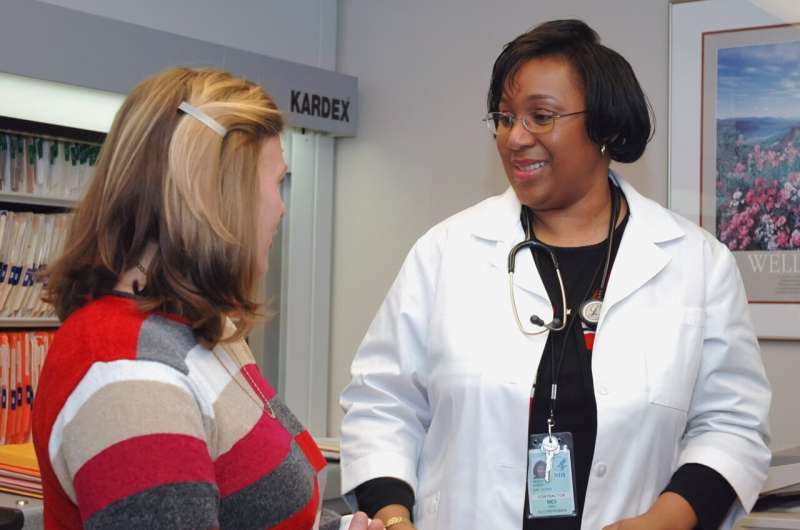This article has been reviewed according to Science X's editorial process and policies. Editors have highlighted the following attributes while ensuring the content's credibility:
fact-checked
peer-reviewed publication
trusted source
proofread
Having a 'regular doctor' can significantly reduce GP workload, study finds

If all GP practices moved to a model where patients saw the same doctor at each visit, it could significantly reduce doctor workload while improving patient health, a study suggests.
In one of the largest studies of its kind, researchers from the University of Cambridge and INSEAD analyzed data from more than 10 million consultations in 381 English primary care practices over a period of 11 years.
The results, reported in the journal Management Science, suggest that a long-term relationship between a patient and their doctor could both improve patient health and reduce workload for GPs.
The researchers found that when patients were able to see their regular doctor for a consultation—a model known as continuity of care—they waited on average 18% longer between visits, compared to patients who saw a different doctor. The productivity benefit of continuity of care was larger for older patients, those with multiple chronic conditions, and individuals with mental health conditions.
Although it will not always be possible for a patient to see their regular GP, this productivity differential would translate to an estimated 5% reduction in consultations if all practices in England were providing the level of care continuity of the best 10% of practices.
Primary care in the U.K. is under enormous strain: patients struggle to get appointments, GPs are retiring early, and financial pressures are causing some practices to close. According to the Health Foundation and the Nuffield Trust, there is a significant shortfall of GPs in England, with a projected 15% increase required in the workforce. The problem is not limited to the U.K., however. The Association of American Medical Colleges estimates a shortfall of between 21,400 and 55,200 primary care physicians in the U.S. by 2033.
"Productivity is a huge problem across all the whole of the U.K.—we wanted to see how that's been playing out in GP practices," said Dr. Harshita Kajaria-Montag, the study's lead author, who is now based at the Kelley School of Business at Indiana University. "Does the rapid access model make GPs more productive?"
"You can measure the productivity of GP surgeries in two ways: how many patients can you see in a day, or how much health can you provide in a day for those patients," said co-author Professor Stefan Scholtes from Cambridge Judge Business School. "Some GP surgeries are industrialized in their approach: Each patient will get seven or 10 minutes before the GP has to move on to the next one."
At English GP practices, roughly half of all appointments are with a patient's regular doctor, but this number has been steadily declining over the past decade as GP practices come under increasing strain.
The researchers used an anonymized dataset from the UK Clinical Practice Research Datalink, consisting of more than 10 million GP visits between 1 January 2007 and 31 December 2017.
Using statistical models to account for confounding and selection bias, and restricting the sample to consultations with patients who had at least three consultations over the past two years, the researchers found that the time to a patient's next visit is substantially longer when the patient sees the doctor they have seen most frequently over the past two years, while there is no operationally meaningful difference in consultation duration.
"The impact is substantial: it could be the equivalent of increasing the GP workforce by 5%, which would significantly benefit both patients and the NHS," said Scholtes. "Better health translates into less demand for future consultations. Prioritizing continuity of care is crucial in enhancing productivity."
"The benefits of continuity of care are obvious from a relationship point of view," said Kajaria-Montag. "If you're a patient with complex health needs, you don't want to have to explain your whole health history at every appointment. If you have a regular doctor who's familiar with your history, it's a far more efficient use of time, for doctor and patient."
"A regular doctor may have a larger incentive to take more time to treat her regular patients thoroughly than a transactional provider," said Scholtes. "Getting it right the first time will reduce her future workload by preventing revisits, which would likely be her responsibility, while a transactional provider is less likely to see the patient for her next visit."
The researchers emphasize that continuity of care does not only have the known benefits of better patient outcomes, better patient and GP experience, and reduced secondary care use, but also provides a surprisingly large productivity benefit for the GP practices themselves.
More information: Harshita Kajaria-Montag et al, Continuity of Care Increases Physician Productivity in Primary Care, Management Science (2024). DOI: 10.1287/mnsc.2021.02015





















